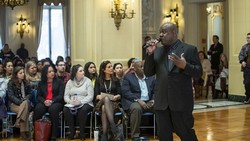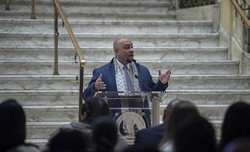The Dr. Martin Luther King Jr. Distinguished Speaker in Social Justice annual lecture, which honors those who carry on the legacy of Rev. Dr. Martin Luther King Jr., featured Raymond Santana Jr. on Wednesday, Jan. 29.
Santana is part of the “Exonerated Five,” a nickname given to a group of teenage boys who were tried and convicted of a crime they did not commit. Each teenage boy spent an individual 5 years in prison before DNA evidence and a confession from the true perpetrator saw the conviction overturned.
Zaneta Rago-Craft, Ed.D., the inaugural director of the Intercultural Center, addressed the crowd and detailed the agenda for the event.
“Faculty, staff, administrators, distinguished alumni, trustees and community members, I want to sincerely thank you for joining us tonight,” Rago-Craft said. “The event is organized on an annual basis by the President’s advisory council on diversity and inclusion. With funding, guidance and support from the officers of the President and Provost, without whom the program would not be possible.”
Before Santana’s keynote lecture, Rago-Craft introduced a spoken word performance of “The King’s Dream” by Key Arts Productions. The performance chronicled different moments of King’s life, intertwining his message with live vocal performances of culturally significant music.
Joseph Patterson, President and Artistic Director of Key Note Productions, led and narrated the performance.
 “I’m going to take you on a brief journey of the life of Dr. Martin Luther King Jr.,” Patterson said.
“I’m going to take you on a brief journey of the life of Dr. Martin Luther King Jr.,” Patterson said.
“As you know, Dr. Martin Luther King Jr., was a man with a dream and a vision. It’s great that he was here on your campus many years ago. I wish I were here for that. There were many college students like yourselves who left the comforts of their dorms to go out and make a difference, and hopefully you’ll be inspired by this program.”
Patterson’s narration detailed the motivation behind the civil rights movement and the 1963 March on Washington, citing a near 500 years ago when “… Africans were brought to America to be bought and sold to work like beasts of burden.”
President Abraham Lincoln’s Emancipation Proclamation officially ended slavey, Patterson explained, but African Americans were still not free to live where they chose, acquire a decent paying job or recieve a quality education.
Rekha Datta, Ph.D., appointed interim provost and vice president for academic affairs, followed Patterson’s performance with thoughts of her own regarding the afternoon gathering.
“Dr. King’s dream lives on and performances like this really help us keep dreaming,” Datta said. “Thank you Zaneta [Rago-Craft] for bringing such a wonderful event and afternoon together. It is my humbled honor and privilege to be standing here in this great hall. This great hall has brought us the opportunity for our campus community to engage with topics of social justice, diversity and inclusion. The theme for this year’s lecture is, and I quote, one of Dr. King’s very famous sayings, ‘Injustice anywhere is a threat to justice everywhere.’ We have the privilege today of having none other than Raymond Santana share his incredible story surrounding his own search for justice within our community.”
Santana began his remarks with a better understanding of his mindset at the time of his arrest.
“It’s an honor to be here today, thank you for having me,” Santana began. “I was a 14 year old boy in 1989. I had no clue about the law, I was just living my life as a 14 year old kid. Not worried about tomorrow, just living in the present, not really knowing what I wanted to do with my life. In April 1989, I, along with 4 other guys, were arrested, charged, tried and convicted of the rape and attempted murder of a central park jogger.”
A multitude of articles were written about Santana, using phrases such as “Wolf Pack,” “Urban Terrorists,” and “Super Predators” to describe the group of boys, Santana said
“We were given these handles because of the picture that was painted against our people, against our community,” Santana explained. “They took these pictures of us in the courtroom and turned them into drawings for the 6 o’clock news. Some of us were even drawn looking like animals. That made you assume we probably did do something. The same tactic was used against Trayvon Martin.”
Santana explained the lack of physical evidence tying him and the other boys to the crime, as no hair samples, foot prints, hand prints, blood samples or saliva could accurately be attributed.
“How was it that a whole world, a whole nation could believe that 4 boys were guilty when there was no physical evidence?” Santana questioned. “How did the whole world buy this story, hook, line and sinker? The only thing there was a statement, and if you took that statement, it read, ‘it was approximately 1700 hours when myself and 4 other friends traveled south to central park.’ What 14 year old boy speaks like that? But America bought it.”
Eventually realizing higher education would be the solution to his incarceration, Santana acquired his GED, attended pre-college and graduated from college. “I was in prison, not knowing what I was going to do with my life or where I was going to go, but I had one thing that was in my favor and that was education.”
The criminal justice system is complex and one idea might not be the answer, so you must approach things from different angles, Santana said.
“The bottom line is that I never want to see another ‘Central Park 5,” Santana said. “I have to do my duty to come out and tell my story, because we are the example of what happens when the system goes wrong and takes your whole world with you. It was on the backs of 5 kids, and we had to carry that for all those years and still carry it to this day. In closing, I just want to say thank you for having me. It’s an honor to be here today, and I can’t wait to see you on the battlefield.”
PHOTOS COURTESY of Monmouth University




